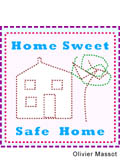- Publications:
- Newsletter:
- How-To Tutorials:
- Consumer Guides:
- Related:

Whole-House Inspection
Checklist of Safety Hazards

Whole-House Safety Checklist
By Al Ubell and Label Shulman
Published June 6, 2004 - Family Circle Magazine
Download PDF: Whole-House Safety Checklist (195KB)
Updated: March 14, 2005

Every year almost 7 million people are injured in and around the house. About 30,000 of those mishaps prove fatal. The shame is that most were preventable accidents. Make your house a “home-sweet-accident-proof-home” by taking our quiz to see how safe your abode really is.
Give yourself 25 points for each “yes” answer on our checklist. For each question that doesn't apply to you—for instance you don't have children or an elderly person living with you, or no garage or workshop—give yourself 20 bonus points. Tally up your total score to rate your sense of safety.
 Danger Zones in the Home:
Danger Zones in the Home:
- ____ All-Around-the-House Habits
- ____ Bathroom Basics
- ____ Appliance Safeguards
- ____ Kitchen: Cooking with Caution
- ____ Wiring: Electrical Hazards
- ____ Fireproof: Fire and Burn Prevention
- ____ Garage and Workshop Rules
Start Your Inspection!!!
All-Around-the-House Habits
- All steps, stoops and stairwells are in good condition (no loose carpeting, dim lighting, clutter) and have secure handrails, bolted to the walls with long-enough screws.
- You have a sturdy stepladder or step stool with a front hold bar to reach high areas. Standing on folding chairs, swivel chairs or desk chairs is a common cause of falls.
- Freestanding furniture such as bookshelves and storage units are secured to a wall with angled brackets and screws or bolts. If the center of gravity is off kilter—say you place heavy items on a top shelf—the unit can topple.
- Concrete and masonry exterior walks, steps and stoops are unpainted. Painted masonry becomes slippery during rainy or damp weather. To fix, repaint with a nonslip additive in the paint to prevent slipping.
- Fire escapes are uncluttered, scraped free of corrosion and painted. You check periodically to see if ladders are in good operating condition.
- You know where all your gas and water cutoff valves are located, and how to close them. If necessary, apply tags to identify valve operation.
- In older homes, you are diligent in preventing children from ingesting flaking or peeling paints on walls, baseboards and radiators. Be sure to repaint every three to four years to keep those surfaces in good condition.
- The vent stack connection of your heating system or hot water system is professionally checked every year to prevent toxic gases from entering your home. Heating systems that use oil, gas, coal or wood must be connected to a chimney with a vent stack.
- Your clothes dryer is vented directly to the outside, not up a chimney flue, or into another room. The lint from a dryer's exhaust can adhere to walls, floors and furniture. It is combustible and the fumes may be toxic.
- You're aware of the warning signs that signal the presence of carbon monoxide in your home: moisture on windows, smell of high humidity in the house and black streaks on walls surrounding radiators, electrical outlets and switch covers.
- If you purchased portable emergency ladders for second-floor bedrooms, you've held fire drills to practice using them. These have been associated with injuries among unskilled users.

Bathroom Basics
- Medicines are clearly labeled for internal or external use and you flush outdated prescriptions down the toilet.
- Your water heater temperature is not greater than 120°F (run the water and test with a meat thermometer). If you can't adjust your water heater, install an anti-scald device (available at hardware stores) on bathtub faucets and showerheads.
- You have installed nonslip mats or rough-surfaced adhesive strips on the floors of your shower and bathtub.
- You never leave a small child or a physically disabled or elderly, frail person alone in the bathtub.
- Bathroom light switches are located far away from the tub or shower, so you must get out of the bath to turn them on or off. If you can reach them, hire an electrician to relocate the switches.
- The door's lock can be opened from the outside in case of an emergency. If not, install a safety bathroom latch (found at local hardware stores).

Appliance Safeguards
- All of your appliances have Underwriter's Laboratory (UL) listings. A UL listing is an assurance that the product has been tested in accordance with nationally recognized safety standards.
- You never place electrical appliances next to heating equipment, such as a radiator. Also, your radiator is covered with a frame that is not touching the unit.
- You always replace worn electrical cords or plugs before they become a hazard; they are responsible for far too many household fires.
- You avoid using extension cords. If one is required, you use a cord with the same or greater wattage and/or amperage value than the appliance.
- You keep cords to lamps, appliances, TVs, etc., out of high-traffic areas. Many mishaps occur because children and adults trip on cords or accidentally pull cords, causing items to be pulled down on top of them.

Kitchen: Cooking with Caution
- Your kitchen knives are stored in a block, not loose in a drawer where a person can grab the blade.
- You never use wet towels to grab hot metal pot handles. Hot handles turn water to steam and will scald your hands through the towel.
- If you have small children at home, you make it a habit to cook on the back burners with pot handles turned inward, away from the stove's edge.
- You prevent your toddler from pulling a table setting down by using place mats instead of a tablecloth.
- You never heat sugar-topped or sugar-filled pastries in a toaster. The sugar can ooze, gum up the toaster and cause a fire.
- If you own a gas grill, you know how to check the propane tank for leaks. (Spray or wipe liquid soap around fittings to make sure no gas is leaking. The soap will bubble if it is.)

Wiring: Electrical Hazards
- If your home was built between 1964 and 1973, you've had your wiring checked to determine if you have aluminum wiring. If so, the electrician made appropriate repairs to prevent fire hazards. More than two million homes were fitted with aluminum wiring during these years, and it has been found to be incompatible with other devices in switches and circuit protectors. For more information, call the U.S. Consumer Product Safety Commission Hotline at 800-638-2772 or visit them at www.cpsc.gov.
- You have a full circuit breaker panel box instead of fuses. Also, your circuit breakers are properly marked.
- The electrical panel box has a main disconnect to cut off all power to the entire building. This is an important safety feature in case you smell smoke or have an electrical fire.
- All rooms with running water are protected with ground fault circuit interrupters (a GFCI receptacle outlet or circuit breaker). This GFCI could prevent a fatal electric shock from an electrical appliance that accidentally comes into contact with water in bathrooms, kitchens, laundry rooms and in outdoor areas. If you don't have GFCIs, ask your electrician about installing these devices.
- You never run extension cords or wiring under carpeting or rugs. The cords may overheat and cause fires.
- You purchase extension cords that have a 15-amp or greater rating capacity.
- You use three-wire extension cords for appliances with three-pronged plugs. Absolutely never snip off the third prong!
- If you have tots or toddlers, you have purchased the new type of extension cords with “anti-mouth-burn” design features such as safety closures and caps. Children sometimes put extension cord receptacles or appliance cord plugs into their mouths and can receive severe shocks or disfiguring burns to the mouth.
- You check the support stanchion and building bracket located outside (it attaches the overhead power line to your home) to see if it is loose or broken. This is especially important in icy or snowy regions.

Fireproof: Fire and Burn Prevention
- You have at least two dry-chemical fire extinguishers mounted in strategic areas (the kitchen and near bedrooms), and know how to use them. Also, you check the pressure gauge on fire extinguishers at least twice a year.
- You discard oily rags or keep them in a closed fireproof metal container to prevent spontaneous combustion.
- Flammable liquids (cleaning fluids, contact adhesives, aerosols) are never stored near the stove or other heat sources. Even pilot lights can set vapors on fire.
- Telephone numbers of the fire department, police emergency, ambulance and local poison control center are posted in a convenient and conspicuous spot known to all family members.
- You test your smoke alarms at least every six months. Two seasonal cues to remind you when it's time to change your batteries: the switch to daylight saving and standard time.

Garage and Workshop Rules
- All household and cleaning chemicals are clearly marked and stored in a cool, dry area, out of reach of children and pets.
- You always wear shoes when walking in a workshop, garage or furnace and hot water heater areas. Nails, screws, tacks, metal filings, splinters, bits of glass or broken plastic have an affinity for bare feet!
- You store gasoline only in laboratory-tested metal containers that have a pressure-relief cap and proper pouring spout. The container is clearly labeled and stored in a cool location.
- You never carry a gasoline can in your car. In the event of an accident, a small amount of gasoline can act like a stick of dynamite; even vapors can be ignited by sparks!
- Glues and adhesives are kept out of children's reach, especially cyanoacrylates used in instant adhesives or quick-curing glues.
- Your electric garage-door opener is equipped with a “safety stop” mechanism to prevent it from injuring people. Test the door periodically by closing it on a wooden box, chair or picnic table bench.

Ok you got this far!
Now Tally up your total scores to rate your sense of safety.

The maximum number of safety points you could have is 1,125.

Copyright © Alvin Ubell, Label Shulman & Family Circle Magazine - 2004




